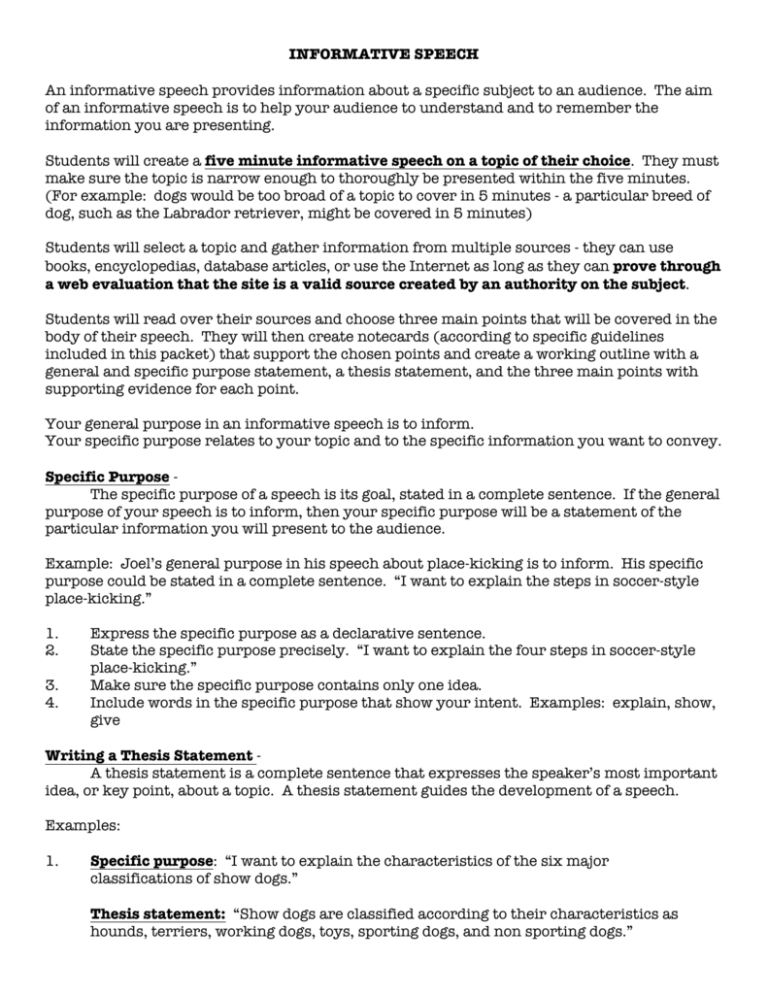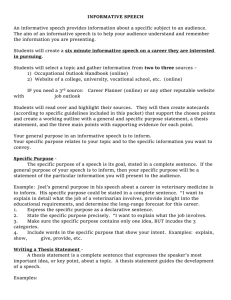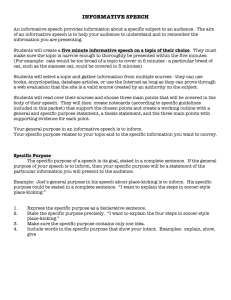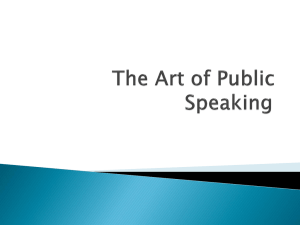Informative Speech Guidelines for Students
advertisement

INFORMATIVE SPEECH An informative speech provides information about a specific subject to an audience. The aim of an informative speech is to help your audience to understand and to remember the information you are presenting. Students will create a five minute informative speech on a topic of their choice. They must make sure the topic is narrow enough to thoroughly be presented within the five minutes. (For example: dogs would be too broad of a topic to cover in 5 minutes - a particular breed of dog, such as the Labrador retriever, might be covered in 5 minutes) Students will select a topic and gather information from multiple sources - they can use books, encyclopedias, database articles, or use the Internet as long as they can prove through a web evaluation that the site is a valid source created by an authority on the subject. Students will read over their sources and choose three main points that will be covered in the body of their speech. They will then create notecards (according to specific guidelines included in this packet) that support the chosen points and create a working outline with a general and specific purpose statement, a thesis statement, and the three main points with supporting evidence for each point. Your general purpose in an informative speech is to inform. Your specific purpose relates to your topic and to the specific information you want to convey. Specific Purpose The specific purpose of a speech is its goal, stated in a complete sentence. If the general purpose of your speech is to inform, then your specific purpose will be a statement of the particular information you will present to the audience. Example: Joel’s general purpose in his speech about place-kicking is to inform. His specific purpose could be stated in a complete sentence. “I want to explain the steps in soccer-style place-kicking.” 1. 2. 3. 4. Express the specific purpose as a declarative sentence. State the specific purpose precisely. “I want to explain the four steps in soccer-style place-kicking.” Make sure the specific purpose contains only one idea. Include words in the specific purpose that show your intent. Examples: explain, show, give Writing a Thesis Statement A thesis statement is a complete sentence that expresses the speaker’s most important idea, or key point, about a topic. A thesis statement guides the development of a speech. Examples: 1. Specific purpose: “I want to explain the characteristics of the six major classifications of show dogs.” Thesis statement: “Show dogs are classified according to their characteristics as hounds, terriers, working dogs, toys, sporting dogs, and non sporting dogs.” 2. Specific purpose: “I want to convince the class that they should read “To Kill a Mockingbird.” Thesis statement: “To Kill a Mockingbird is an excellent book to read because it features interesting characters, thought-provoking issues, and an exciting plot.” If you already know a great deal about your topic, you can write your thesis statement at this stage of your planning. For most speeches, however, you will need to do some research first. SAMPLE Subject Area: football Topic: place-kicking Limited Topic: soccer-style place-kicking General Purpose: to inform Specific Purpose: I want to explain the four steps in soccer-style place-kicking. Thesis Statement: The four steps in soccer-style place-kicking are to spot the ball, to mark off the steps, to approach the ball,, and to kick the ball. Supporting Your Thesis Statement You need to find information to support your main idea as expressed in your thesis statement. The types of details commonly used to support a thesis include facts, opinions, examples, illustrations, anecdotes, statistics, comparisons, definitions, descriptions, and quotations. 1) Facts and Opinions: Statement of fact contain information that can be proved, or verified, by testing, by observing, or by consulting reference materials. Statement of opinion expresses personal beliefs or attitudes. Such statements contain personal judgments, which include information that cannot be proved. In some situations, you may seek an expert opinion. An expert opinion is a statement of belief about a subject from a person who is recognized as an authority on that subject. For example, a rocket scientist could offer an expert opinion on space travel. Experts can also supply facts. For instance, a high school coach can report on how many college recruiters have visited players on the team. 2) Examples and illustrations: An example is a single instance that supports or develops a statement. An illustration is a detailed example. 3) Anecdotes: Anecdotes are brief, often amusing, stories. The purpose of an anecdote is to give information in a form that an audience will remember. Because anecdotes are often entertaining, they can help make your speech more interesting and enjoyable as well as informative. 4) Statistics: Statistics are numerical facts: “Only six out of every ten registered voters voted in the last school election” or “unemployment recently dropped 2 percent.” Citing a few statistics may make your speech more informative, but giving too many statistics can be boring or distracting. Use statistics carefully to add interest or to emphasize a point. 5) Comparisons: A comparison is a statement that shows the similarities between people, places, things, events, or ideas. Comparisons help listeners relate new ideas to familiar concepts. A figurative comparison imaginatively shows similarities between things that are essentially not alike. For example, you may say someone is “as slow as molasses in January” to point out that the person moves slowly. A literal comparison shows the real similarities between things that are essentially alike. Example - “Tom runs slower than Jorge.” 6) Occasionally, a comparison is phrased as a contrast, highlighting the differences between two things. For instance, you might say, “Unlike last year’s ecology club, which consisted primarily of seniors, this year’s club has mostly sophomores and juniors as members.” Definitions: A definition explains what a word or a concept means. You should define carefully any words or concepts your audience may not understand. 7) Descriptions: A description is a word picture of a person, place, thing, or event. Accurate descriptions help people in your audience form mental pictures that correspond to the actual thing described. 8) Quotations: A quotation expresses someone’s exact words. Usually, you express your ideas in your own words. However, in some cases you will use a quotation to express the opinion of an authority or to include a particularly well stated idea. When you use quotations, you must give credit to the source from which the words were taken. The more convincingly you can show your listeners that you know about your topic, the more likely they are to pay attention and to remember what you say. The final step in preparing your material is to organize it. A well-organized speech has three parts: an introduction, a body, and a conclusion. Introduction: Body: Conclusion: gains the attention and the goodwill of the audience presents the main points in an organized pattern and gives supporting information for the main points. emphasizes key idea or ideas of the speech and leaves the audience with greater interest in the topic. Planning the Introduction The beginning section of your speech is the introduction. An introduction can be as short as a few sentences and should usually be no longer than 10 percent of the speech. Length varies, depending on the topic, the audience’s interest level, and the audience’s knowledge about the subject. An introduction serves three very important purposes. It should: 1) get the attention of the audience - (sustained interest) - you need to find a way to focus the audience’s attention on the subject matter of your speech, then, when you get into the body of the speech, your audience will continue to listen. 2) gain the goodwill of the audience - (audience’s respect or positive feeling for the speaker as a person) - What you say in your opening remarks and the way in which you say it - your tone, your inflection, and other nonverbal signals are important. If your audience likes or trusts you, they will likely be willing to listen to what you have to say and to think about your message. 3) develop the audience’s interest in the topic of the speech - (involvement or concern your audience shows about your topic) - Include facts, examples, and other information that will hold your audience’s attention. You can use any of the common methods for beginning a speech - a startling statement, a question, a quotation, a story, or a personal reference - in an informative speech. Using transitional devices Transitional devices are bridges between ideas. They connect parts of a speech and help to emphasize the points you are making. Example: Between the opening and the body of your speech about dogs being our best friends, you might say, “First, let’s look at ways dogs help people.” Between the first and second points you might say, “Now that we have seen examples of how dogs work with people, let’s move on to our second point.” Transitional devices also help you emphasize ideas. For example, you might say, “Here is a point I want to stress,” or “The key point here is . . .” Statements like these alert your audience to be prepared to hear information that you think is important. Audiovisual materials are resources that a speaker uses to help listeners retain information. They can: **Save time in explanation **Clarify a point **Help an audience remember important material Sometimes you can find audiovisual materials --such as charts, diagrams, photographs, audio, graphs, or maps - already prepared. Organizing the Body of an Informative Speech The body of a speech is the portion in which the main points are developed. To organize the body of a speech, you will need to 1) 2) 3) determine the main points you want to stress organize the main points in a consistent pattern the audience can follow outline all the material you plan to use in the speech Because the body of a speech contains the most important ideas that will be presented, many experienced speakers prepare it first. Then, after they know the development of the main ideas, they usually find the introduction and conclusion easier to prepare. Determining the Main Points The main points of a speech are the major ideas under which the supporting information is organized. If you have composed a well-written specific purpose, then determining the main points of your speech should be fairly easy. The specific purpose or the thesis statement lead to the wording of the main points. Example: Specific Purpose: I want to explain the three ways that dogs have shown themselves to be our “best friends.” Thesis Statement: Dogs have earned their place as our “best friends” by working with people, by protecting people and their property, and by showing love and devotion to people. Main Points: I. Dogs work with people. II. Dogs protect people and their property. III. Dogs show love and devotion to people. The main points of your speech may be organized in any of a number of logical patterns. The three most common methods of arrangement are chronological order, spatial order, and topical order. 1) Chronological Order - arranges details or events according to the order in which they occurred in time. Chronological order is often useful for speeches that present a history of something. To make remembering easier for your audience, group the steps in chronological order under broad headings. Chronological Example: Specific purpose: I want to explain the five stages in the evolution of the bicycle. I. The first stage is the origin. II. The second stage is the development of a steering device. III. The third stage is the attachment of pedals to the front wheel. IV. The fourth stage is the addition of chain drive. V. The fifth stage is the development of modern safety features. 2) Topical Order - a topic is broken down into its parts and then arranged in an order determined by the speaker and stated in the specific purpose. This is the most common method for organizing speeches. Topical Order Example: Specific purpose: I want to discuss three measures of the strength of the United States as a world power. I. One measure of U.S. strength is its natural resources. II. A second measure of U.S. strength is its military. III. A third measure of U.S. strength is its technology. 3) Spatial Order - details are arranged according to their position in space. This arrangement is often used for descriptions. Spatial Order Example: Specific purpose: I want to describe the three levels of the Community Center. I. The basement contains various recreational facilities. II. The main floor contains restaurants and administrative offices. III. The second floor contains an auditorium, smaller meeting rooms, and a banquet room. 4) Climactic Order - arranges items according to their order of importance, usually starting with the least important item of information and ending with the item of information that is the most important. 5) Cause-and-Effect Order - information is arranged to show causes or conditions and the effects or results of those causes or conditions. 6) Comparison-and-contrast Order - items of information are arranged to show the similarities and differences between the items. Developing the Main Points Once you have determined the main points of your speech and have made an informal plan of organization, you can arrange your supporting information under appropriate headings. Remember that the main points provide a basic structure that you fill out with supporting information. As you sort and arrange your supporting material to group related ideas, take care to keep unity in mind. A speech is unified when all its parts fit together to make a whole and all of the information contained in the speech relates to the specific purpose. The best way to plan a unified speech is to prepare an informal outline. Preparing your Conclusion The conclusion of an informative speech usually includes a summary of the main points. Many speakers end with a quotation, an anecdote, or a final thought that makes the conclusion more memorable. The conclusion is the final portion of a speech. Although a conclusion is seldom longer than a few sentences, it is very important. The goals of an effective conclusion are: 1) 2) to emphasize the key idea or ideas of the speech to intensify the emotions, or feelings, of the audience Delivering Your Speech Any speech will be more effective if it is delivered well. 1) Credibility - A speaker’s credibility is the amount of trust and belief the speaker inspires in an audience. You want to establish yourself as a speaker whom the audience can trust to give accurate information. One way to do this is to tell the audience a little about your background or experience to let your audience know what makes you qualified to talk about your topic. Be thoroughly prepared, but if you do not know something or if experts are still debating a point, freely admit this. 2) Enthusiasm - Be enthusiastic about your topic. Your audience will probably find it difficult to become excited about the topic you are speaking about if you do not seem to find it important or interesting. The more enthusiasm you show, the more likely you are to get and to hold the audience’s attention. 3) Eye contact - Establish eye contact with your listeners. If you look at the members of your audience, they will look at you. If you fail to establish eye contact, the members of the audience will let their eyes - and their attention - wander. 4) Vocal Variety and Emphasis - Vary your tone, rate, volume, and pitch to emphasize key points and to make your speech more interesting. 5) Clear Articulation and Enunciation - Be careful not to slur your words. When you speak clearly, your audience will find listening to your message easy and enjoyable. 6) Good Pronunciation - Your pronunciation can either help or hurt your credibility. If you mispronounce key words in your speech, your listeners will begin to question whether you have a thorough knowledge of your subject.








